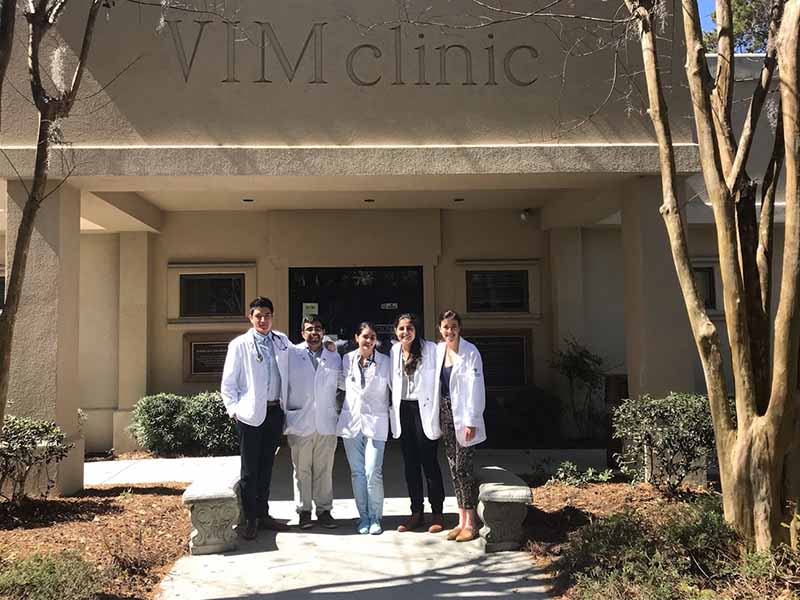
Hilton Head Island in South Carolina is known as a beautiful vacation destination filled with southern charm and the character of a resort town. But five Wayne State medical students saw it as an area in need of medical volunteers, traveling there at the end of their first year of medical school to shadow and translate for the physicians and staff at the Volunteers in Medicine Clinic, or VIM, on Hilton Head Island.
The trip to Hilton Head in March 2019 was organized by Amigos Medicos, a chapter of the Latino Medical Student Association. Amigos Medicos works to improve the health of the Latino and Hispanic patient population through volunteering and cultivating members of the Wayne State University School of Medicine community to become better physicians for Latino and Hispanic populations.
“While the weather and scenery are beautiful in Hilton Head, one in five people on the island are medically uninsured. In an effort to correct this gap in health care, the Volunteers in Medicine clinic was established as the first free clinic in the country,” explained medical student Rafael Ramos, Class of 2022.
Most of the practicing physicians are retired and work at the VIM clinic as a way to help the community. The clinic is funded entirely by donations and remains in operation because of the staff’s volunteer efforts.
Hilton Head Island is located near Port Royal Sound, which was a Spanish fort settlement in the 1500s called Santa Elena. As of the 2010 census, the Hispanic population on Hilton Head Island was 15.8%, which is significantly larger than the Hispanic populations in other resort towns in the southern United States.
“Many of the individuals treated at the clinic are of Hispanic origin and English is a second language for many of them, some having little to no experience with it. This means that there is a language and cultural barrier, which sometimes exists in the care they receive despite the clinic’s best efforts,” Ramos said.
“This is where we found our niche as medical student volunteers. All five medical students who partook in this trip were comfortable communicating in Spanish to work as interpreters for the staff and physicians. All of us were paired with physicians of different specialties over our one-week stay, and did our best to be linguistic bridges during key aspects of the visit, such as obtaining patient histories and explaining follow up procedures and medication instructions,” Ramos added.
The students learned unique approaches to health care with the VIMs model and worked with physicians across many specialties, rotating through internal medicine, orthopedics, nephrology, pediatrics, surgery, family medicine, obstetrics and gynecology, endocrinology, rheumatology and cardiology.
“This variety definitely brought our general knowledge to the forefront, with the added bonus of having to translate key terms in layman-Spanish. This ability to translate also provided a unique spin on the traditional shadowing experience, as we became key players in the care of each of the patients we had a chance to work with,” Ramos said.
The physicians-in-training also participated in the clinic’s efforts to highlight the preventative measures for patients to manage their health, with some days entirely dedicated to counseling for chronic conditions such as diabetes and hypertension.
The curriculum at the School of Medicine emphasizes active learning and constant integration to build skills and knowledge simultaneously. It also enables physicians-in-training to customize their studies, with time for electives and career choice exploration, including opportunities to focus on the health of the underserved populations.
“The five of us really got a chance to get to know each other over our weeklong experience, and in so doing we happened to reflect a lot on our medical school experiences up to that point. The new curriculum has made a point of highlighting key social determinants of health, empathy during patient interaction, and has placed a focus on getting all first years with basic clinical skill maneuvers. All of these were brought to the forefront during our experience, as we all found ourselves capable of guiding the conversations when interacting with the patients and obtaining key information to help the doctors make the best diagnosis,” Ramos said.
“Moreover, we all had experiences where we were the ones explaining the diagnosis and necessary follow-up procedures in a calm manner to the people we were working with. These were skills we all refined during our initial experiences at WSU, and the ability to engage and volunteer in such a manner definitely reminded us why we need to slog through long hours of study to become the best physicians we can.”
Ramos added that the students had a “lovely surprise in being able to work with two Wayne State University School of Medicine graduates who now live in South Carolina.” They are Carl Samberg, M.D., Class of 1959, and Lydia Torres-Rozof, M.D., Class of 1992.